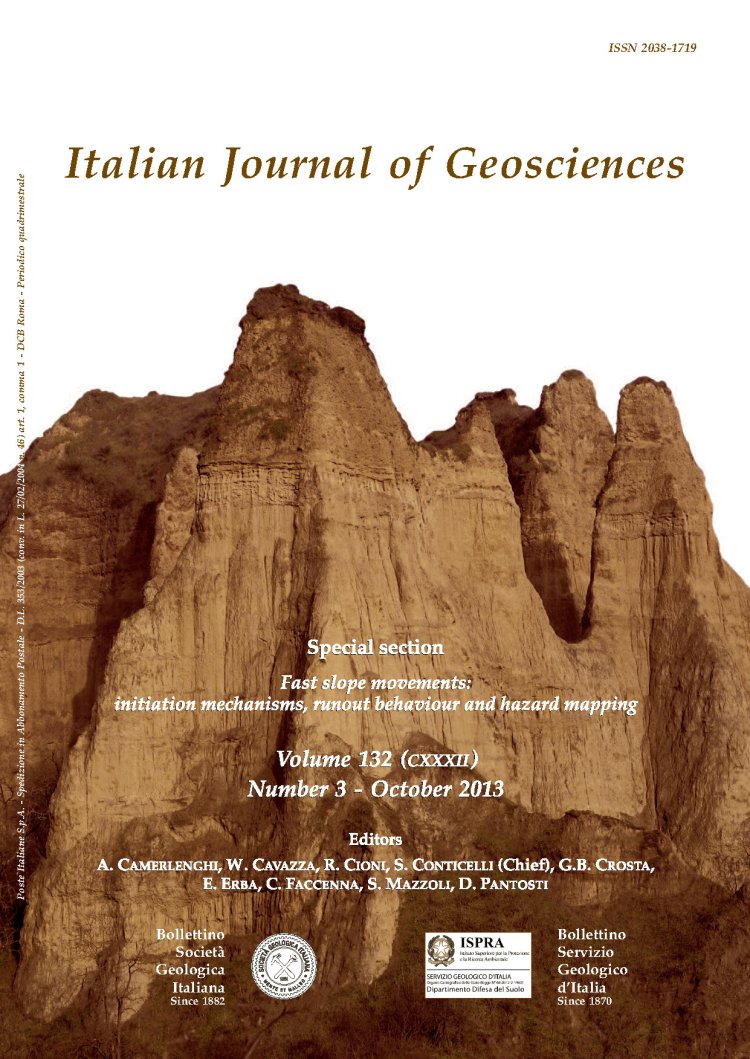
High-resolution δ13C stratigraphy through the Selli Oceanic Anoxic Event (OAE1a) in the Apulia carbonate platform: the Borgo Celano section (western Gargano Promontory, Southern Italy)
Roberto Graziano(*), Arturo Raspini(**) & Luigi Spalluto(***)
(*) Dipartimento di Scienze della Terra, dell'Ambiente e delle Risorse, Università di Napoli Federico II, Largo S. Marcellino, 10 - 80138 Napoli. E-mail: rgrazian@unina.it
(**) Istituto di Geoscienze e Georisorse (IGG), CNR, Via G. La Pira, 4 - 50121 Firenze. E-mail: raspini@igg.cnr.it
(***) Dipartimento di Scienze della Terra e Geoambientali, Università degli Studi di Bari "A. Moro", Via E. Orabona, 4 - 70125 Bari. E-mail: luigi.spalluto@uniba.it
DOI: https://doi.org/10.3301/IJG.2013.16
Volume: 132 (2013) f.3
Pages: 477-496
Abstract
We show that the global-scale environmental perturbations leading to the Selli OAE1a were clearly recorded in the middle Bedoulian Apulia carbonate platform at Borgo Celano, in the western Gargano Promontory (Southern Italy). The studied section (Bari Limestones), which is 72.45 m thick and spans the Late Barremian p.p.-latest Early Aptian time interval, has been logged with an average resolution of 3 samples per metre for chemostratigraphic analyses
and up to 7 samples per metre for facies analysis in the aim of detailed paleocologic and paleoceanographic investigation. It contains the complete biosedimentary and chemostratigraphic record across the Selli OAE1a, as suggested by a consistent match of the observed isotope excursions with those documented in the Cismon pelagic reference section and the lack of significant non-depositional or erosional hiatuses within the chemostratigraphic Selli level: biostratigraphic and sedimentary-diagenetic analyses document a continuous record of fully subtidal conditions. Furthermore, the Borgo Celano section allows correlation of the shallow- and deep-water records without intervening stratigraphic breaks. Upper Barremian-Lower Bedoulian, chlorozoan-type carbonates showing subtidalintertidal Milankovitch-type cyclicities characterize the lower part of the Borgo Celano section (C2 pro parte isotopic segment). Starting from the latest C2 segment, a remarkable Crisis Interval (CI) about 4 m thick shows an increasing frequency of bivalves (Chondrodonta and requieniids), the disappearance of green algae and a reduced diversity of foraminiferal assemblages (foramol-type carbonates).
This interval is sharply overlain by an interval, about 3.70 m thick, that is largely dominated by "out-of-balance" microbial limestones almost devoid of metazoans, apart from sparse, small-sized requieniids and Chondrodonta, which accompanies the C3-middle C4 isotope segment. It is interpreted to reflect a sharp hyperthermal and acidification event induced by excess pCO2. Starting from the upper C4 segment, less severe but still threatening environmental conditions permitted the deposition throughout the lower C5 segment of peculiar shallow-water tropical-like carbonates, which are dominated by oncoidal floatstones and microbial wackestone/packstone emphasizing the enduring influence of benthic cyanobacteria during the Selli OAE1a. Upsection guilds are dominated by foraminiferal and peloidal wackestones/packstones with sparse bivalves and green algae (upper C5-lowermost C7 isotope segments). Similarly to other carbonate platforms of the central Tethyan Realm (e.g., Apennine
and Adriatic), the resilience of the Apulia carbonate platform inner shelf to the environmental perturbations that led to the coeval drowning of its margin, the starvation of its slope and to the deposition of black shales in the bounding Ionian basin is a striking supraregional feature. The inception of the resilience of the Apulia carbonate platform inner shelf is coincident with the lithostratigraphic boundary in between the Borgo Celano and Chondrodonta and requieniids members of the Bari Limestones and physically corresponds in the field with the base of a significant, 1 m thick, Chondrodonta-rich marker bed. These observations confirm the value of routinely applied field and laboratory studies for precise chemostratigraphic and bio-chronostratigraphic correlations on a regional scale. Furthermore, chemostratigraphic data presented here corroborate recent paleoceanographic and stratigraphic models proposed for the Lower Aptian across the transition between the Apulia carbonate platform and the bounding Ionian basin, and provide further elements for regional reconstructions of historical patterns.
Keywords
Oceanic Anoxic Events, Selli Level, Apulia carbonate platform, Aptian, chemostratigraphy, platform drowning, microbialites, biosphere-geosphere interactions.
Get Full Text